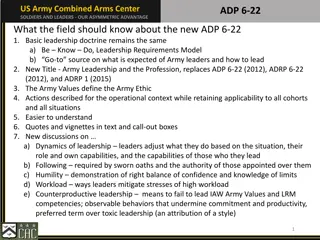Sales Leadership Management
Marketing channel decisions play a crucial role in the success or failure of products in both B2C and B2B markets. This chapter explores the importance of effective channel management, types of channels, the role of intermediaries in streamlining transactions, and the distinction between marketing channels and supply chains. The focus is on explaining the factors that impact channel decisions, conflict resolution in channels, and strategies for achieving cooperation among channel members.
Download Presentation

Please find below an Image/Link to download the presentation.
The content on the website is provided AS IS for your information and personal use only. It may not be sold, licensed, or shared on other websites without obtaining consent from the author.If you encounter any issues during the download, it is possible that the publisher has removed the file from their server.
You are allowed to download the files provided on this website for personal or commercial use, subject to the condition that they are used lawfully. All files are the property of their respective owners.
The content on the website is provided AS IS for your information and personal use only. It may not be sold, licensed, or shared on other websites without obtaining consent from the author.
E N D
Presentation Transcript
Sales Leadership Management Chapter 12: Channel Sales Partners Unless otherwise noted, this work is licensed under a Creative Commons Attribution-NonCommercial- ShareAlike 4.0 International (CC BY-NC-SA 4.0) license. Feel free to use, modify, reuse or redistribute any portion of this presentation.
12.0 Learning Outcomes In this chapter, we will: Explain why marketing channel decisions can result in the success or failure of products. Describe the basic types of channels in business-to-consumer (B2C) and business-to-business (B2B) markets. Explain the advantages and challenges companies face when using multiple channels and alternate channels. Discuss how third party sales are different than direct sales. Describe the factors that affect a firm s channel decisions. Outline the five steps in the channel management process. Describe the types of conflicts that can occur in marketing channels. Describe the ways in which channel members achieve cooperation with one another.
12.1 Marketing Channels and Channel Partners Today, marketing channel decisions are as important as the decisions companies make about the features and prices of products. Consumers have become more demanding. How companies sell has become as important as what they sell. The firms a company partners with to actively promote and sell a product as it travels through its marketing channel to users are referred to by the firm as its channel members (or partners). The simplest marketing channel consists of just two parties a producer and a consumer. Products and services may pass through multiple organizations before they get to you. These organizations are called intermediaries (or middlemen or resellers). The intermediaries can help companies sell the products better than they could working alone. There are four forms of utility, or value, that channels offer. These are time, form, place, and ownership.
12.1 Marketing Channels and Channel Partners Intermediaries also create efficiencies by streamlining the number of transactions an organization must make, each of which takes time and costs money to conduct. The marketing environment is always changing, so what was a great channel or channel partner yesterday might not be a great channel partner today Using Intermediaries to Streamline the Number of Transactions
12.1 Marketing Channels versus Supply Chains All the organizations that figure into any part of the process of producing, promoting, and delivering an offering to its user are considered part of the offering s supply chain. These types of firms aren t considered channel partners because it s not their job to actively sell the products being produced. Nonetheless, they all contribute to a product s success or failure. Firms are constantly monitoring their supply chains and tinkering with them so they re as efficient as possible. This process is called supply chain management.
12.1 Types of Channel Partners - Wholesalers Wholesalers Obtain large quantities of products from producers, store them, and break them down into cases and other smaller units more convenient for retailers to buy, a process called breaking bulk. There are many types of wholesalers: Merchant Wholesalers are wholesalers that take title to the goods. They are also sometimes referred to as distributors, dealers, and jobbers. Brokers, or agents, don t purchase or take title to the products they sell. Their role is limited to negotiating sales contracts for producers. Manufacturers Sales Offices or Branches are selling units that work directly for manufacturers. These are found in business-to-business settings.
12.1 Types of Channel Partners - Retailers Retailers buy products from wholesalers, agents, or distributors and then sell them to consumers. Supermarkets or grocery stores, are self-service retailers that provide a full range of food products to consumers, as well as some household products. Drugstores specialize in selling over-the-counter medications, prescriptions, and health and beauty products and offer services such as photo developing. Convenience stores are miniature supermarkets. Many of them sell gasoline and are open twenty-four hours a day. Specialty stores sell a certain type of product, but they usually carry a deep line of it. Superstores are oversized department stores that carry a broad array of general merchandise as well as groceries. Warehouse clubs are supercentres that sell products at a discount. They require people who shop with them to become members by paying an annual fee.
12.2 Typical Marketing Channels The shortest marketing channel consists of just two parties a producer and a consumer. A channel such as this is a direct channel. By contrast, a channel that includes one or more intermediaries say, a wholesaler, distributor, or broker or agent is an indirect channel. In an indirect channel, the product passes through one or more intermediaries. That doesn t mean the producer will do no marketing directly to consumers. Typical Channels in Business-to-Consumer (B2C) Markets
12.2 Typical Marketing Channels Notice how the channels resemble those in B2C markets, except that the products are sold to businesses and governments instead of consumers like you. The industrial distributors shown in. the figure are firms that supply products that businesses or government departments and agencies use but don t resell. Typical Channels in Business-to-Business (B2B) Markets
12.2 Disinitermediation Disintermediation is the process of cutting out the middlemen or intermediaries. Sometimes cutting out the middleman is desirable but not always. A wholesaler with buying power and excellent warehousing capabilities might be able to purchase, store, and deliver a product to a seller more cheaply than its producer could acting alone. Hiring a distributor will cost a producer money. The distributor can help the producer sell greater quantities of a product, increasing the producer s profits. You have to perform the functions the middlemen once did. The Internet has facilitated a certain amount of disintermediation by making it easier for consumers and businesses to contact one another without going through any middlemen. Sometimes it s simply impossible to cut out middlemen. (Coca-Cola Company for example)
12.2 Multiple Channels and Alternate Channels In some situations, a wholesaler will sell to brokers, who then sell to retailers and consumers. In other situations, a wholesaler will sell straight to retailers or straight to consumers. Manufacturers also sell straight to consumers, and, as we explained, sell straight to large retailers. The key is understanding the different target markets for your product and designing the best channel to meet the needs of customers in each. Using multiple channels can be effective. Some companies find ways to increase their sales by forming strategic channel alliances with one another. Alternate Channel Arrangements
12.2 International Marketing Channels The question is how to enter these markets? Via what marketing channels? Acquiring part or all of a foreign company is a common strategy for companies. Corruption and unstable governments also make it difficult to do business in some countries. Use intermediaries, like joint ventures. It is an entity created when two parties agree to share their profits, losses, and control with one another in an economic activity they jointly undertake. Simply export your products. Companies can sell their products directly to other firms abroad, or they can hire intermediaries such as brokers and agents that specialize in international exporting to help them find potential buyers for their products. Franchising: this grants an independent operator the right to use a company s business model, name, techniques, and trademarks for a fee. Licensing is similar to franchising. For a fee, a firm can buy the right to use another firm s manufacturing processes, trade secrets, patents, and trademarks for a certain period of time.
12.3 Third-Party Sales Third-party sales are sales conducted by anyone other than the producer. Even when there are four or five parties involved, we refer to all of them as third parties. Third-party sales are often vexing for marketers. It is much more difficult to understand and influence the sales process. Direct sales involve selling products directly to consumers through company-owned channels, offering more control over marketing, brand image, and pricing. Third-party sales involve selling products through retailers, where the company has less control over marketing and sales strategies, and the focus is on maximizing sales regardless of the brand. Approaches to Support Third-Party Sales Success: Understand and align incentives. Provide exceptional sales support. Create demand for your product. 1. 2. 3.
12.4 Channel Selection Factors Selecting the best marketing channel is critical because it can mean the success or failure of your product. The Business Environment and Technology Competing Products Marketing Channels Channel Partner Capabilities Type of Customer Type of Product how your customers want to buy products. Is perishable or valuable product? Some have to be sold through shorter marketing channels than others. Your ability versus the ability of other types of organizations that operate in marketing channels. Consider the general business environment, such as the economy or technological changes(internet). How your competitors sell their products. You don t always have to choose the channels your competitors rely on.
12.4 Factors That Affect a Products Intensity of Distribution Intensive Distribution Try to sell their products in as many outlets as possible. Are often used for convenience offerings. Selective Distribution Involves selling products at select outlets in specific locations. By selling different models with different features and price points at different outlets, a manufacturer can appeal to different target markets. Exclusive Distribution Involves selling products through one or very few outlets. Exclusive simply means limiting distribution to only one outlet in any area and can be a strategic decision based on applying the scarcity principle to creating demand.
12.5 Channel Management Process 1. Analyze the Consumer. Identify customers and their needs. Understand buying behavior and preferences. Establish the Channel Objectives. Set goals based on customer requirements and company strategy. Specify Distribution Tasks. Define specific functions for the channel system. Evaluate and Select Among Channel Alternatives. Determining the specific channel tasks is a prerequisite of the evaluation and selection process. There are four considerations for channel alternatives: number of levels, intensity at the various levels, types of intermediaries at each level, and application of selection criteria to channel alternatives. Decide who will be in charge of the selected channels. Evaluate Channel Member Performance. Measure performance and make improvements if necessary. 2. 3. 4. 5.
12.6 Managing Channel Conflicts In a distribution channel, conflict usually arises in one of two forms: structural or behavioural. Channel conflict is a dispute among channel members. Vertical conflict is a conflict that occurs between two different types of members in a channel (a manufacturer, an agent, a wholesaler, or a retailer). Horizontal conflict is a conflict that occurs between organizations of the same type (two manufacturers that each want a powerful wholesaler to carry only its products). Companies aim to foster cooperation with channel partners to achieve common goals. Strategies include providing sales incentives, creating marketing materials, and educating sales representatives. Building relationships and emphasizing benefits of working together can strengthen cooperation.
12.6 Channel Integration: Vertical and Horizontal Marketing Systems Another way to foster cooperation in a channel is to establish a vertical marketing system. In a vertical marketing system, channel members formally agree to closely cooperate with one another. A vertical integration is when one channel member takes over the functions of another member. Vertical integration can be forward, or downstream. Backward integration occurs when a company moves upstream in the supply chain. Franchises are another type of vertical marketing system. In a conventional marketing system the channel members have no affiliation with one another. All the members operate independently. Horizontal marketing system is one in which two companies at the same channel level agree to cooperate with another to sell their products or to make the most of their marketing opportunities, and is sometimes called horizontal integration.























